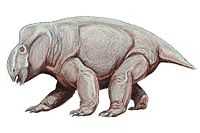1904 in paleontology
| List of years in paleontology (table) |
|---|
| ... 1894 . 1895 . 1896 . 1897 . 1898 . 1899 . 1900 ... 1901 1902 1903 -1904- 1905 1906 1907 ... 1908 . 1909 . 1910 . 1911 . 1912 . 1913 . 1914 ... In science: 1901 1902 1903 -1904- 1905 1906 1907 |
| Art . Archaeology . Architecture . Literature . Music . Philosophy . Science +... |
Paleontology, palaeontology or palæontology (from Greek: paleo, "ancient"; ontos, "being"; and logos, "knowledge") is the study of prehistoric life forms on Earth through the examination of plant and animal fossils.[1] This includes the study of body fossils, tracks (ichnites), burrows, cast-off parts, fossilised feces (coprolites), palynomorphs and chemical residues. Because mankind has encountered fossils for millennia, paleontology has a long history both before and after becoming formalized as a science. This article records significant discoveries and events related to paleontology that occurred in the year 1904.
Dinosaurs
Newly named dinosaurs
Data courtesy of George Olshevsky's dinosaur genera list[2] and Dr. Jeremy Montague's dinosaur genus database.[3]
| Name | Novelty | Status | Authors | Age | Unit | Location | Notes | Images |
|---|---|---|---|---|---|---|---|---|
|
Gen et sp nov |
Broom |
now considered an indeterminate sauropod |
| |||||
|
gen et sp nov |
Valid |
Dinosaur Park Formation, Alberta |
Type species: Centrosaurus apertus |
| ||||
Plesiosaurs
- Plesiosaur gastroliths documented.[6]
Synapsids
Non-mammalian
| Name | Novelty | Status | Authors | Age | Unit | Location | Notes | Images |
|---|---|---|---|---|---|---|---|---|
|
Gen et sp nov |
Valid |
| ||||||
|
Gen et sp nov |
Valid |
Lucas |
Chinle Formation, Arizona |
| ||||
|
Gen et sp nov |
Valid |
|||||||
|
Gen et sp nov |
Valid |
|||||||
References
- ↑ Gini-Newman, Garfield; Graham, Elizabeth (2001). Echoes from the past: world history to the 16th century. Toronto: McGraw-Hill Ryerson Ltd. ISBN 9780070887398. OCLC 46769716.
- ↑ Olshevsky, George. "Dinogeorge's Dinosaur Genera List". Retrieved 2008-08-07.
- ↑ Montague, Jeremy. "Dr. Montague's Database". Retrieved 2008-10-29.
- ↑ Broom, R. 1904. On the occurrence of an opisthocoelian dinosaur (Algoasaurus bauri) in the Cretaceous beds of South Africa. Geol. Mag., ser. 5 (1): 445-447.
- ↑ Lambe, L. M. 1904. On the squamoso-parietal crest of two species of horned dinosaurs from the Cretaceous of Alberta. Ottawa Nat. 18: pp. 81-84.
- ↑ Brown (1904). Williston (1904). Sanders, Manley, and Carpenter (2001), "Table 12.1" page 167.
- Brown, B. (1904) Stomach stones and food of plesiosaurs, Science, n.s. 20, (501): 184-185
- Sanders F, Manley K, Carpenter K. Gastroliths from the Lower Cretaceous sauropod Cedarosaurus weiskopfae. In: Tanke D.H, Carpenter K, editors. Mesozoic vertebrate life: new research inspired by the paleontology of Philip J. Currie. Indiana University Press; Bloomington, IN: 2001. pp. 166–180.
- Williston, Samuel Wendel; 1904; The stomach stones of the plesiosaurs; Science; 20 pp. 565; American Association for the Advancement of Science



